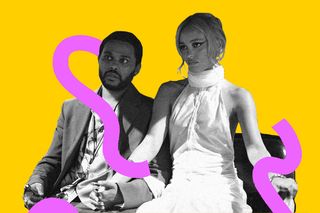
Should the Awfulness of ‘The Idol’ Change How We Look Back at ‘Euphoria’?
It’s difficult to look back on Euphoria in hindsight and not conclude that Euphoria walked so The Idol could run. In the wrong direction.

It turns out that the red herring all along was the hairbrush, not the Weeknd’s atrocious rat-tail—shocker! The season finale of The Idol is simultaneously shockingly underwhelming and just what we expected from Sam Levinson’s latest venture into visualising kinks for public voyeurism. A project mired in controversy weeks before its release, The Idol was HBO’s attempt at leveraging Levinson’s supposed genius, with a heavy dose of established bad boy/sad boy Abel “The Weeknd” Tesfaye thrown in for muted, neon colour. It was, ostensibly, a show exploring fame, celebrity culture, and the cost of stardom, but one which missed the mark in more ways than one. Instead, The Idol was unable to overcome the spectacle of its behind-the-scenes drama with an unusually short five-episode season—even with the borderline NC-17 sex scenes. Not even Lily-Rose Depp’s enviable cheekbones could save this latest instalment of the Euphoria-verse.
Behind-the-scenes issues aren’t new in showbiz; after all, the term ‘production hell’ exists for a reason. Apocalypse Now, Francis Ford Coppola’s Vietnam War-inspired Heart of Darkness homage, was infamous for an endless series of production-ending problems miring the set. Trouble-free filmmaking is as rare as a footless Tarantino flick. Similarly with The Idol, the now-infamous Rolling Stone exposé from March revealed the depth of the “shitshow”. Calling it “twisted, torture porn,” the article lambasted the US$110 million project and detailed the dramatic overhaul of its creative direction, which turned it from a feminist perspective on super-stardom headed by Amy Seimetiz of The Girlfriend Experience into an Euphoria spin-off: one with more sex, worse dialogue, and significantly more nipples. It’s safe to say that Levinson turned an emerging archetype into a canonical one: the sexy complex woman.
Sam Levinson’s proclivity for hyper-sexualised underaged characters is well known—several actors from Euphoria have come out publicly about the sheer amount of scripted nudity in the show. In a Vanity Fair article, Minka Kelly revealed that her character Samantha was originally written to be nude in the closet scene; drug dealer Laurie, played by Martha Kelly, was meant to undress Rue (Zendaya) before injecting her with morphine: “[It was] approaching this gross paedophilia vibe,” Kelly told Dazed. “It’s difficult to want to play a character that hurts kids; Faye (Chloe Cherry), blood-spattered, was stuffed into a vent in season two episode two—originally, she was meant to do it completely naked. Sydney Sweeney (playing the fandom-hated Cassie) had to ask if some of her characters’ topless scenes were even necessary. One is an accident, twice is a coincidence, and three times is happenstance: we must ask why these clarifications were even necessary, and what this says about Sam Levinson’s approach to portraying the complexity of women’s lives. It seems as though he deems it worth exploring if the women in question meet the requisite bar of sex appeal and, in The Idol’s case, if the women navigate their trauma through kinky sex. Not only does it undermine the trauma, it also undermines the nuances of kink.
All too often, the empowerment of women is interlinked with sexual explicitness, and while this may be true in many instances, it’s not true of situations in which men mediate this empowerment through their idea of empowering sex. Often, couched in the language of empowerment, is sex that depicts women “reclaiming” total submission – sexual and otherwise – to a man, as seen with both Cassie and Jocelyn. Consequently, the actors suffer. Sweeney, the most frequent target of Levinson’s proclivity for sexualising blonde women, has pointed out the double-standards in male vs female nudity: “When a guy has a sex scene or shows his body, he still wins awards and gets praise. But the moment a girl does it, it’s completely different,” she told Dazed, discussing how her performance on Euphoria was overshadowed by her constant on-screen nudity. “I do The White Lotus and all of the sudden, critics are paying attention.” While Euphoria was able to draw out praiseworthy performances (see Zendaya and her multiple accolades) and a meandering but interesting storyline, The Idol is all style, no substance.
Related on The Swaddle:
‘Euphoria’ Is the Wokest Show to Fail the Bechdel Test
One could argue that the inclusion of nudity and violence is for artistic value; a way to show a characters’ inner turmoil, grief, and pain. Certainly, that appears to be Sam Levinson’s perspective; when facing criticism over the extent of explicit content in Euphoria, and now in The Idol, the director defended himself. “It’s funny, sometimes things that might be revolutionary are taken too far,” Levinson said at the press conference following The Idol’s Cannes premiere. Calling The Idol ‘revolutionary’ might indeed be taking it too far—beyond gif-worthy shots and high production value, and of course the star-studded cast (see BLACKPINK’s Jennie, who was told to “sit and look pretty”), few things are truly noteworthy in this show. Even the sex scenes, which received the most coverage online, are disappointing at best and bizarre at worst; episode two’s infamous scene involved Jocelyn (Lily-Rose Depp) masturbating blindfolded while The Weeknd’s Tedros crouched gremlin-like behind a chair spewing some truly adolescent-level dirty-talk. It’s a testament to Depp’s acting that her attraction to Tedros is mostly believable; the less said about Tesfaye’s dead eyed, monotonous performance, the better.
In his attempt to shock his audience by bombarding them with ‘provocative’ scenes, Sam Levinson has actually given us the perfect example of why men creating sexually empowered female characters is a lesson in futility. Not only are they laughably obvious in the voyeurism of their gaze, their understanding of what empowerment means dramatically falls short. The ‘shocking’ twist in episode five was that Jocelyn’s mother’s abuse, one of the few compelling aspects of The Idol’s plot, was completely fabricated. Instead of an exploration of the trauma Jocelyn faced by her now-deceased mother, her team’s muted compliance, and the continuing repercussions on her mental health, the final episode turned Jocelyn into a cult-like leader who now had the upper hand on Tedros. Gaslight gatekeep girlboss, indeed. Beyond lacking any internal logic or continuity, this drastic flip to Jocelyn’s character shows how male directors like Sam Levinson mistake manipulation for strength. The uneven power dynamics between Tedros and Jocelyn was present from episode one—this is a relationship which mistakes aggression for strength of desire, and abuse for sexual excitement and experimentation. Jocelyn’s response to her assistant/best friend Leia’s (Rachel Sennott) concern about Tedros being ‘rapey’ could only be something written by a man: “I kinda like that about him.” Girl, what? Blink twice if you’re being held hostage.
Jocelyn’s final transformation into a white-clad cult-leader makes it clear what Levininson thinks power or revenge looks like for a woman—manipulation, abuse, and unequal dynamics. To make things worse, that rat tail still haunts my waking hours.
The Idol tries to be profound and edgy through its depiction of morally-nuanced characters, but is at odds with itself. Glorifying mental illness as “sexy,” a conversation on bodily autonomy and oversexualisation of women leading to a bathroom-trapped intimacy coordinator and ‘empowering’ nude photoshoot, a scene involving breathplay and erotic asphyxiation tiptoeing into full on non-consensual sex, and glossed-over sexual assault. It’s difficult to look back on Euphoria in hindsight and not conclude that Euphoria walked so The Idol could run. In the wrong direction.
Nothing could make it clearer the extent to which Sam Levinson has used The Idol, and Euphoria before it, as thinly-veiled wish fulfilment: seeing naked, or nearly naked, girls in borderline sexually abusive scenes. This isn’t the work of a genius—Levinson is simply a grown up nepo baby hailed as a genius for creating TikTok-worthy aesthetic visuals being given an obscene budget and an international platform to depict his voyeurism kink. And that’s before we even discuss his Oedipal complex.
Akankshya Bahinipaty writes about the intersection of gender, queerness, and race, especially in the South Asian context. Her background in political science and communication have shaped her past multimedia and broadcasting experience, and also her interest in current events.
Related


Sizzle This: Barbie the Feminist Movie Now Has Merch, Coming Full Circle
